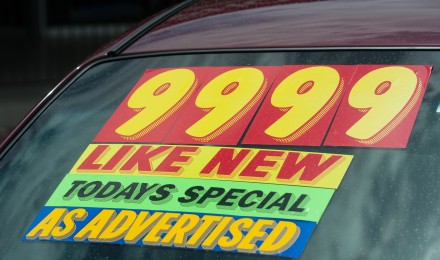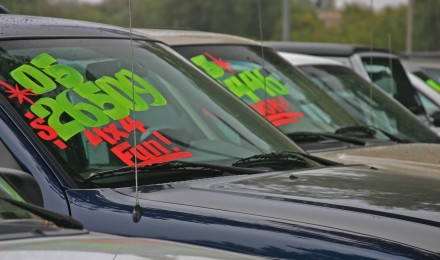While the great recession continues its slow way to recovering a bright spot for consumers is that lenders are beginning to lend money for car buyers. While the American made new car market especially is growing, many folks have been scared by economic hard times and have damaged credit ratings. For them, it is probably easier to buy a used car.
Sure, the interest rates will be a bit higher, but the amount of the loan will be lower, so on balance, you can afford and finance a nice used car. It is important though to bear in mind that financing a used car through an auto dealership (used or new car dealer that sells used cars too) is far easier than trying to finance a car that you buy privately.
If it has been a while since you have made a major purpose remember to use credit wisely.
Tip 1: Set a budget before you visit a dealership. Most personal financial experts think that the maximum monthly expense for a car should be 18 percent or less of your take home pay. That should include not just your car payment, but gas and insurance too.
Tip 2: Do a credit check. You are entitled to a free annual credit report from each of the following credit bureaus:
If there are any discrepancies in your credit reports fix them, if you owe any money pay the debt and then design a strategy for dealing with the lender over any negative information in your report.
Tip 3: Get a pre-approved loan. This allows you to focus on your negotiation for the car without the distraction and anxiety of knowing that you also have to negotiate a loan. As a buyer, you know in advance, what you can afford – and with a preapproved loan in your pocket, should the dealer offer to finance you know at once if the rate is good. Car buyers who will be borrowers with poor credit can avoid rejection by shopping for a loan before they go car buying from a sub-prime lender. These lenders are now getting back into the auto-financing arena. Search online for the best rates.
Tip 4: Make a 20 percent down payment. A down payment of 20 percent will keep creditworthy buyers safe from becoming upside-down on their car debt. This occurs when you owe more on the car than the car is worth. Subprime buyers will have to put down 20 percent in order to maximize the likelihood of obtaining financing.
Tip 5: Perceptive buyers will save for the down payment. Getting a personal loan to make the down payment means higher monthly costs. If you have trouble qualifying for a loan but are sure that payments will not be a problem then having a qualified co-buyer can enhance your chances of being financed and the rate may be a bit lower.
A few words of caution: never leave cash deposit on a used car, if you decide against buying you may not get it back. Always get a Carfax report and have the car checked out by a qualified mechanic before you purchase.
While the great recession continues its slow way to recovering a bright spot for consumers is that lenders are beginning to lend money for car buyers. While the American made new car market especially is growing, many folks have been scared by economic hard times and have damaged credit ratings. For them, it is probably easier to buy a used car.
Sure, the interest rates will be a bit higher, but the amount of the loan will be lower, so on balance, you can afford and finance a nice used car. It is important though to bear in mind that financing a used car through an auto dealership (used or new car dealer that sells used cars too) is far easier than trying to finance a car that you buy privately.
If it has been a while since you have made a major purpose remember to use credit wisely.
Tip 1: Set a budget before you visit a dealership. Most personal financial experts think that the maximum monthly expense for a car should be 18 percent or less of your take home pay. That should include not just your car payment, but gas and insurance too.
Tip 2: Do a credit check. You are entitled to a free annual credit report from each of the following credit bureaus:
If there are any discrepancies in your credit reports fix them, if you owe any money pay the debt and then design a strategy for dealing with the lender over any negative information in your report.
Tip 3: Get a pre-approved loan. This allows you to focus on your negotiation for the car without the distraction and anxiety of knowing that you also have to negotiate a loan. As a buyer, you know in advance, what you can afford – and with a preapproved loan in your pocket, should the dealer offer to finance you know at once if the rate is good. Car buyers who will be borrowers with poor credit can avoid rejection by shopping for a loan before they go car buying from a sub-prime lender. These lenders are now getting back into the auto-financing arena. Search online for the best rates.
Tip 4: Make a 20 percent down payment. A down payment of 20 percent will keep creditworthy buyers safe from becoming upside-down on their car debt. This occurs when you owe more on the car than the car is worth. Subprime buyers will have to put down 20 percent in order to maximize the likelihood of obtaining financing.
Tip 5: Perceptive buyers will save for the down payment. Getting a personal loan to make the down payment means higher monthly costs. If you have trouble qualifying for a loan but are sure that payments will not be a problem then having a qualified co-buyer can enhance your chances of being financed and the rate may be a bit lower.
A few words of caution: never leave cash deposit on a used car, if you decide against buying you may not get it back. Always get a Carfax report and have the car checked out by a qualified mechanic before you purchase.







